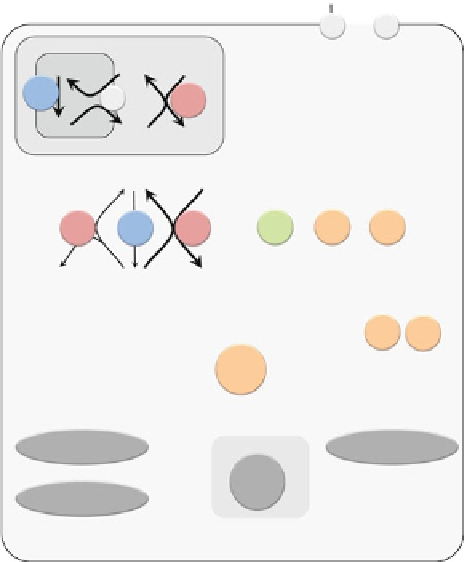Biology Reference
In-Depth Information
cytokines
hormones
Ca
2+
24
cytosolic ATP consumpon
Rec
Ch
PCr
Cr
Pi
mitochondrion
ADP
ATP
synth
matrix
ADP
Cr
16
ANT
mtCK
AT P
AT P
PCr
8
AMP
AT P
Metabolic control
of AMPK acvaon
ADP
AT P
PCr
0
32
16
0
Total ~P (μmoles g
-1
)
ATP-
dep.
Cam
KKβ
CK
PP
LKB1
AK
AMP
ADP
Cr
Covalent acvaon
(phosphorylaon)
metabolite fluxes
signaling fluxes
acvaon
inhibion
mitochondrial creane kinase
cytosolic creane kinase
cytosolic adenylate kinase
mitochondrial ATP synthase
ATP-dependent enzymes
-
+
-
Akt
PKA
-
+
+
mtCK
CK
AK
ATP synth.
ATP-dep.
-
AMPK
Non-covalent acvaon
Crosstalk (phosphorylaon)
other
substrates
-
catabolic enzymes
+
nucleus
+
or
AMPK
PP
LKB1
CamKKβ
AMP-acvated protein kinase
protein phosphatases
liver kinase B1
calmodulin kinase kinase
+
trans-
cripon
factors
-
anabolic enzymes
ANT
Rec
Ch
adenylate translocase
receptor
channel
Effects on key metabolic enzymes
Effects on gene transcripon
Other effects
Fig. 11.13
AMPK signaling. Large scheme: Activation of AMPK by intra- and extracellular
metabolic and endocrine signals and major fields of downstream signaling
. Activation of AMPK
is determined by upstream kinases (covalent activation by LKB1, CamKK
, inhibition by Akt and
PKA) and phosphatases. They mediate mainly extracellular signals carrying, e.g., information on
the energy and nutrient state of the cellular environment and the entire organism (endocrine
signals). Covalent activation also depends on some intracellular parameters (Ca
2+
, possibly also
ROS/RNS). As a second layer of regulation, AMPK is activated by ADP and in particular AMP
(allosteric regulation), both acting as second messengers of cellular energy stress. This signaling is
linked to conversion of nucleotides via the adenylate kinase (AK) and creatine kinase
(CK) reactions. Activated AMPK compensates for ATP loss by accelerating catabolism, inhibiting
anabolism, and further effects on cell motility, growth, proliferation, and others, via regulation of
key enzymes and transcription factors. For further details see text.
Insert: Connection of AMPK
signaling and phosphotransfer reactions (CK and AK)
(Neumann et al.
2003
). Global cellular
concentration changes of phosphocreatine [PCr] and adenine nucleotides ([ATP], [ADP] and
[AMP]), inorganic phosphate [Pi], and creatine [Cr], calculated from the reactions of CK, AK,
and a generalized ATPase at decreasing “high-energy” phosphates (corresponding to a transition
from rest to high work-load). Note that with “high-energy” phosphate consumption, [ATP]
remains constant until more than 80 % of the PCr pool is consumed. Only then, there is a transient
increase in [ADP] and finally [AMP] starts to rise dramatically. The exponential rise in [AMP]
makes this nucleotide an ideal second messenger for a lowered cellular energy state. This
simplified model assumes that the CK and AK reactions work at equilibrium (which is unlikely
to be true in vivo) and does not account for specific subcellular localizations of CK and AK
β







































Search WWH ::

Custom Search